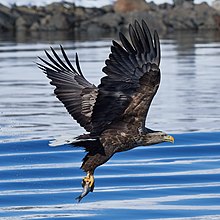
Back Haliaeetus albicilla AN عقاب البحر بيضاء الذيل Arabic عقاب ابيض الذنب ARZ Haliaeetus albicilla AST Ağquyruq dəniz qartalı Azerbaijani Диңгеҙ бөркөтө Bashkir Арлан-белахвост Byelorussian Арлан-белахвост BE-X-OLD Морски орел Bulgarian সাদা লেজধারী ঈগল Bengali/Bangla
| White-tailed eagle | |
|---|---|

| |
| Scientific classification | |
| Domain: | Eukaryota |
| Kingdom: | Animalia |
| Phylum: | Chordata |
| Class: | Aves |
| Order: | Accipitriformes |
| Family: | Accipitridae |
| Genus: | Haliaeetus |
| Species: | H. albicilla
|
| Binomial name | |
| Haliaeetus albicilla (Linnaeus, 1758)
| |
| Subspecies[3] | |
| |

| |
| Range of H. albicilla
Breeding Resident Passage
Non-breeding
Extant & Reintroduced (resident) Extant & Reintroduced (passage)
| |
| Synonyms | |
|
Falco albicilla Linnaeus, 1758 | |
The white-tailed eagle (Haliaeetus albicilla), sometimes known as the 'sea eagle',[4] is a large bird of prey, widely distributed across temperate Eurasia. Like all eagles, it is a member of the family Accipitridae (or accipitrids) which includes other diurnal raptors such as hawks, kites, and harriers. One of up to eleven members in the genus Haliaeetus, which are commonly called sea eagles, it is also referred to as the white-tailed sea-eagle.[5] Sometimes, it is known as the ern or erne (depending on spelling by sources),[6] gray sea eagle[7] and Eurasian sea eagle.[8]
While found across a wide range, today breeding as far west as Greenland and Iceland across to as far east as Hokkaido, Japan, they are often scarce and spottily distributed as a nesting species, mainly due to human activities. These have included habitat alterations and destruction of wetlands, about a hundred years of systematic persecution by humans (from the early 1800s to around World War II) followed by inadvertent poisonings and epidemics of nesting failures due to various manmade chemical pesticides and organic compounds, which have threatened eagles since roughly the 1950s and continue to be a potential concern. Due to this, the white-tailed eagle was considered endangered or extinct in several countries.[6][9][10][11] However, some populations have recovered well due to some governmental protections and dedicated conservationists and naturalists protecting habitats and nesting sites and partially regulating poaching and pesticide usage, as well as careful reintroductions into parts of their former range.[12][13][14]
White-tailed eagles usually live most of the year near large bodies of open water, including coastal saltwater areas and inland freshwater lakes, wetlands, bogs and rivers. It requires old-growth trees or ample sea cliffs for nesting,[6][12] and an abundant food supply of fish and birds (largely water birds) amongst nearly any other available prey.[6][12] Both a powerful apex predator and an opportunistic scavenger, it forms a species pair with the bald eagle (Haliaeetus leucocephalus), which occupies a similar niche in North America.[15]
- ^ BirdLife International (2020). "Haliaeetus albicilla". IUCN Red List of Threatened Species. 2020: e.T22695137A181768148. doi:10.2305/IUCN.UK.2020-3.RLTS.T22695137A181768148.en. Retrieved 19 November 2021.
- ^ "Appendices | CITES". cites.org. Retrieved 14 January 2022.
- ^ Gill F, D Donsker & P Rasmussen (Eds). 2020. IOC World Bird List (v10.2). doi : 10.14344/IOC.ML.10.2.
- ^ "White-tailed eagle | The Wildlife Trusts". www.wildlifetrusts.org.
- ^ Helander, B., & Stjernberg, T. (2003). Action plan for the conservation of white-tailed sea eagle (Haliaeetus albicilla). In Convention on the Conservation of European Wildlife and Natural Habitats, Strasbourg, France.
- ^ a b c d Love, J. A. (1983). The return of the Sea Eagle. Cambridge University Press, ISBN 0-521-25513-9.
- ^ Amadon, Dean (1963). "Comparison of fossil and recent species: some difficulties". The Condor. 65 (5): 407–409. doi:10.2307/1365146. JSTOR 1365146. S2CID 73710353.
- ^ Ridgway, R., & Friedmann, H. (1919). The birds of North and Middle America: a descriptive catalogue of the higher groups, genera, species, and subspecies of birds known to occur in North America, from the Arctic lands to the Isthmus of Panama, the West Indies and other islands of the Caribbean sea, and the Galapagos Archipelago (Vol. 50, No. 8). Govt. Print. Off.
- ^ King, W. B., & Vincent, J. (1978). Endangered birds of the world, The ICBP Bird red data book (Vol. 2). Smithsonian Inst Press.
- ^ Hailer, Frank; Gautschi, Barbara; Helander, Björn (2005). "Development and multiplex PCR amplification of novel microsatellite markers in the White-tailed Sea Eagle, Haliaeetus albicilla (Aves: Falconiformes, Accipitridae)". Molecular Ecology Resources. 5 (4): 938–940. doi:10.1111/j.1471-8286.2005.01122.x.
- ^ Krone, Oliver; et al. (2006). "Mortality factors, helminth burden, and contaminant residues in white-tailed sea eagles (Haliaeetus albicilla) from Finland". Ambio: A Journal of the Human Environment. 35 (3): 98–104. doi:10.1579/0044-7447(2006)35[98:MFHBAC]2.0.CO;2. PMID 16846196. S2CID 34897657.
- ^ a b c Ferguson-Lees, James; Christie, David A. (2001). Raptors of the World. Illustrated by Kim Franklin, David Mead, and Philip Burton. Houghton Mifflin. ISBN 978-0-618-12762-7. Retrieved 29 May 2011.
- ^ Krüger, Oliver; Grünkorn, Thomas; Struwe-Juhl, Bernd (2010). "The return of the White-tailed Eagle (Haliaeetus albicilla) to northern Germany: modelling the past to predict the future". Biological Conservation. 143 (3): 710–721. doi:10.1016/j.biocon.2009.12.010.
- ^ Love, J. A. (1988). The reintroduction of the white-tailed sea eagle to Scotland: 1975–1987. Nature Conservancy Council.
- ^ Wink, Heidrich & Fentzloff 1996.
© MMXXIII Rich X Search. We shall prevail. All rights reserved. Rich X Search
